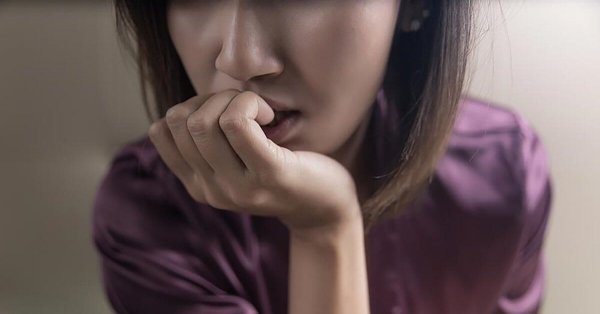Mixed Anxiety-Depressive Disorder: Definition, Causes, and Treatment

Mixed anxiety-depressive disorder has been controversial and not all existing diagnostic classifications include it. It’s not that its existence isn’t recognized, but sometimes it has been considered to be a depressive disorder with secondary anxious characteristics, and not one single disorder.
Mixed anxiety-depressive disorder’s symptoms are anxiety and depression, but none of them clearly predominates. Nor do they have sufficient intensity to justify a separate diagnosis.
This disorder manifests with a mixture of comparatively mild symptoms that are frequently seen in primary care, and its prevalence is even higher in the general population.
The combination of depressive and anxious symptoms causes a significant deterioration in functioning of the affected person.
However, those who oppose this diagnosis have argued that the availability of this diagnosis discourages clinicians from taking the time needed to get a complete psychiatric history of a patient. Such a history would allow them to differentiate true depressive disorders from true anxiety disorders.
When is mixed anxiety-depressive disorder diagnosed?
To diagnose it, there must be symptoms of anxiety and low intensity depression. In addition, there must be some vegetative symptoms like tremors, palpitations, dry mouth and stomach pain.
Some preliminary studies have indicated that general practitioners have low sensitivity for detecting mixed anxiety-depressive disorder syndrome. However, it’s possible that this lack of recognition reflects only the lack of an appropriate diagnostic label for these patients.

Mixed anxiety-depressive disorder symptoms
Clinical manifestations of this disorder combine symptoms of anxiety disorders and symptoms of depressive disorders.
In addition, symptoms of hyperactivity of the autonomic nervous system, such as gastrointestinal discomfort, are frequent. This is often why patients go to medical outpatient clinics.
DSM-IV research criteria for mixed anxiety-depressive disorder
Diagnostic and Statistical Manual of Mental Disorders (DSM) puts forth a series of criteria to diagnose this disorder. However, as we’ve mentioned, it is only for research purposes. Let’s take a look:
The essential characteristic of this disorder is a persistent or recurrent dysphoria that lasts at least 1 month. This state of mind is accompanied by additional symptoms with the same duration, including a minimum of four of the following:
- Difficulty with concentration or memory, sleep disorders, fatigue or lack of energy.
- Acute irritability.
- Recurrent and intense worrying.
- Cries easily, or has feelings of hopelessness, pessimism about the future, uselessness and low self-esteem.
- Hypervigilance, anticipation of danger.
These symptoms cause significant clinical discomfort or deterioration of social, work or other important activities.
On the other hand, mixed anxiety-depressive disorder shouldn’t be the diagnosis when symptoms are due to direct physiological effects of a substance or a medical disease. Or if at any time the individual has met the diagnostic criteria for major depressive disorder, persistent depressive disorder, anxiety disorder or generalized anxiety disorder.
This diagnosis is also inappropriate if the criteria for any other anxiety or mood disorder are met at the same time, even if they’re in partial remission.
It is also necessary that the range of symptoms can’t find a better explanation with another mental disorder. Most initial information about this disorder is from primary care centers, where the disorder seems to be more frequent; it probably also has a higher prevalence among outpatients.

What is the impact of mixed anxiety-depressive disorder?
The coexistence of a major depressive disorder with an anxiety disorder is very common. Two thirds of patients with symptoms of depression also have clear symptoms of anxiety. One third of these may meet diagnostic criteria for panic disorder.
Some researchers have reported that 20% to 90% of all patients with anxiety disorders have episodes of major depressive disorder. This data suggest that the coexistence of symptoms of depression and anxiety that do not meet diagnostic criteria for depressive or anxiety disorders, is very common.
However, at this time there is no formal epidemiological data on mixed anxiety-depressive disorder. But some researchers have estimated that the prevalence of this disorder in the general population is 10%, though in primary care it becomes 50%. More conservative estimates suggest a prevalence of 1% in the general population.
What causes this disorder?
Four lines of research suggest that symptoms of anxiety and depression are linked to identified causes.
First, several researchers have found similar neuroendocrine causes for depressive and anxiety disorders. These include reduction of:
- cortisol’s response to the adrenocorticotropic hormone
- the growth hormone response to clonidine
- the thyroid-stimulating hormone
- the response of prolactin to the thyrotropin-releasing hormone
Secondly, several researchers have presented data that identify hyperactivity of the noradrenergic system as a relevant factor in the origin of depressive and anxiety disorders in some patients

Specifically, these studies have found that patients with depressive or anxiety disorders who are actively experiencing an anxiety crisis have high concentrations of the norepinephrine metabolite MHPG in their urine, plasma, or cerebrospinal fluid.
As with other anxiety and depressive disorders, serotonin and GABA may also be associated with the origin of the mixed anxiety-depressive disorder.
Third, many studies have found that serotonergic medications, such as fluoxetine and clomipramine, are useful in treating both depressive and anxiety disorders.
Finally, several family studies have presented data indicating that anxiety and depressive symptoms are genetically passed on, at least in some families.
The course of the disorder and prognosis
According to current clinical information, it seems that in the beginning, patients may have the same probability of predominant symptoms of anxiety or predominant symptoms of depression, or a proportional mixture of them.
During the course of the disease, anxiety and depressive symptoms may alternate in their predominance. A prognosis is not yet known.
However, separately, depressive and anxiety disorders tend to become chronic without adequate psychological treatment.
Treatment of mixed anxiety-depressive disorder
As there are no good studies comparing methods of treatment for mixed anxiety-depressive disorders, clinicians tend to provide treatment according to symptoms presented, their severity, and their previous experience with the different methods of treatment.
Psychotherapeutic approaches can be used for a short period of time, such as behavioral or cognitive therapies. Still, some clinicians use a less structured psychotherapeutic approach, such as introspection psychotherapy.
Medication
The pharmacological treatment of mixed anxiety-depressive disorders usually is with anti-anxiety drugs, antidepressants or both. Among anxiolytic drugs, some data indicate that the use of triazolobenzodiazepines (for example, alprazolam) may be appropriate, due to its effectiveness in the treatment of depression associated with anxiety.
Substances that affect the 5-HT receptor, such as buspirone, may also be appropriate. Among antidepressants, serotoninergics (eg, fluoxetine) may be very effective in the treatment of mixed anxiety-depressive disorder.

Psychological treatment
In any case, the treatment of choice for these types of pathologies is cognitive-behavioral psychotherapy.
On the one hand, before anything else, it’s about the patient reducing their level of physiological activation. This is achieved through breathing techniques (for example, diaphragmatic breathing) and relaxation techniques (progressive muscle relaxation, autogenic training, mindfulness, etc.).
Second, it is necessary for the patient to improve their mood. This can be achieved in different ways. Behavioral activation therapy can be very effective in this regard.
The idea is for the patient to resume his previous level of activity. To do this, a therapist encourages them to do pleasant activities, either going back to one or participating in a new one gradually.
Third, a period of psychoeducation is useful. In this period, the patient gets an explanation about what is happening to him or her and why. They learn some basic ideas about the characteristics of anxiety and depression so that they can normalize their experience.
Afterwards, it may be necessary to change some beliefs or thoughts that may be feeding the problem. This may be with a cognitive restructuring technique.
As you can see, mixed anxiety-depressive disorder has no specific identity in some diagnostic systems, but it’s frequently found in primary care consultations. It is rather common.
It is a disorder that can be treated, and if not treated in time, can become chronic.
Bibliography:
Bobes García, J. (2001). Trastornos de ansiedad y trastornos depresivos en atención primaria. Barcelona, etc.: Masson.
Derogatis, L. R., & Wise, T. N. (1996). Trastornos depresivos y de ansiedad en asistencia primaria. Barcelona: Martinez Roca.
Miguel Tobal, J.J. (1990). La ansiedad. En J. Mayor y J.L. Pinillos (Eds.). Tratado de Psicología General. (Vol.3). Motivación y Emoción. Madrid: Alhambra.
Mixed anxiety-depressive disorder has been controversial and not all existing diagnostic classifications include it. It’s not that its existence isn’t recognized, but sometimes it has been considered to be a depressive disorder with secondary anxious characteristics, and not one single disorder.
Mixed anxiety-depressive disorder’s symptoms are anxiety and depression, but none of them clearly predominates. Nor do they have sufficient intensity to justify a separate diagnosis.
This disorder manifests with a mixture of comparatively mild symptoms that are frequently seen in primary care, and its prevalence is even higher in the general population.
The combination of depressive and anxious symptoms causes a significant deterioration in functioning of the affected person.
However, those who oppose this diagnosis have argued that the availability of this diagnosis discourages clinicians from taking the time needed to get a complete psychiatric history of a patient. Such a history would allow them to differentiate true depressive disorders from true anxiety disorders.
When is mixed anxiety-depressive disorder diagnosed?
To diagnose it, there must be symptoms of anxiety and low intensity depression. In addition, there must be some vegetative symptoms like tremors, palpitations, dry mouth and stomach pain.
Some preliminary studies have indicated that general practitioners have low sensitivity for detecting mixed anxiety-depressive disorder syndrome. However, it’s possible that this lack of recognition reflects only the lack of an appropriate diagnostic label for these patients.

Mixed anxiety-depressive disorder symptoms
Clinical manifestations of this disorder combine symptoms of anxiety disorders and symptoms of depressive disorders.
In addition, symptoms of hyperactivity of the autonomic nervous system, such as gastrointestinal discomfort, are frequent. This is often why patients go to medical outpatient clinics.
DSM-IV research criteria for mixed anxiety-depressive disorder
Diagnostic and Statistical Manual of Mental Disorders (DSM) puts forth a series of criteria to diagnose this disorder. However, as we’ve mentioned, it is only for research purposes. Let’s take a look:
The essential characteristic of this disorder is a persistent or recurrent dysphoria that lasts at least 1 month. This state of mind is accompanied by additional symptoms with the same duration, including a minimum of four of the following:
- Difficulty with concentration or memory, sleep disorders, fatigue or lack of energy.
- Acute irritability.
- Recurrent and intense worrying.
- Cries easily, or has feelings of hopelessness, pessimism about the future, uselessness and low self-esteem.
- Hypervigilance, anticipation of danger.
These symptoms cause significant clinical discomfort or deterioration of social, work or other important activities.
On the other hand, mixed anxiety-depressive disorder shouldn’t be the diagnosis when symptoms are due to direct physiological effects of a substance or a medical disease. Or if at any time the individual has met the diagnostic criteria for major depressive disorder, persistent depressive disorder, anxiety disorder or generalized anxiety disorder.
This diagnosis is also inappropriate if the criteria for any other anxiety or mood disorder are met at the same time, even if they’re in partial remission.
It is also necessary that the range of symptoms can’t find a better explanation with another mental disorder. Most initial information about this disorder is from primary care centers, where the disorder seems to be more frequent; it probably also has a higher prevalence among outpatients.

What is the impact of mixed anxiety-depressive disorder?
The coexistence of a major depressive disorder with an anxiety disorder is very common. Two thirds of patients with symptoms of depression also have clear symptoms of anxiety. One third of these may meet diagnostic criteria for panic disorder.
Some researchers have reported that 20% to 90% of all patients with anxiety disorders have episodes of major depressive disorder. This data suggest that the coexistence of symptoms of depression and anxiety that do not meet diagnostic criteria for depressive or anxiety disorders, is very common.
However, at this time there is no formal epidemiological data on mixed anxiety-depressive disorder. But some researchers have estimated that the prevalence of this disorder in the general population is 10%, though in primary care it becomes 50%. More conservative estimates suggest a prevalence of 1% in the general population.
What causes this disorder?
Four lines of research suggest that symptoms of anxiety and depression are linked to identified causes.
First, several researchers have found similar neuroendocrine causes for depressive and anxiety disorders. These include reduction of:
- cortisol’s response to the adrenocorticotropic hormone
- the growth hormone response to clonidine
- the thyroid-stimulating hormone
- the response of prolactin to the thyrotropin-releasing hormone
Secondly, several researchers have presented data that identify hyperactivity of the noradrenergic system as a relevant factor in the origin of depressive and anxiety disorders in some patients

Specifically, these studies have found that patients with depressive or anxiety disorders who are actively experiencing an anxiety crisis have high concentrations of the norepinephrine metabolite MHPG in their urine, plasma, or cerebrospinal fluid.
As with other anxiety and depressive disorders, serotonin and GABA may also be associated with the origin of the mixed anxiety-depressive disorder.
Third, many studies have found that serotonergic medications, such as fluoxetine and clomipramine, are useful in treating both depressive and anxiety disorders.
Finally, several family studies have presented data indicating that anxiety and depressive symptoms are genetically passed on, at least in some families.
The course of the disorder and prognosis
According to current clinical information, it seems that in the beginning, patients may have the same probability of predominant symptoms of anxiety or predominant symptoms of depression, or a proportional mixture of them.
During the course of the disease, anxiety and depressive symptoms may alternate in their predominance. A prognosis is not yet known.
However, separately, depressive and anxiety disorders tend to become chronic without adequate psychological treatment.
Treatment of mixed anxiety-depressive disorder
As there are no good studies comparing methods of treatment for mixed anxiety-depressive disorders, clinicians tend to provide treatment according to symptoms presented, their severity, and their previous experience with the different methods of treatment.
Psychotherapeutic approaches can be used for a short period of time, such as behavioral or cognitive therapies. Still, some clinicians use a less structured psychotherapeutic approach, such as introspection psychotherapy.
Medication
The pharmacological treatment of mixed anxiety-depressive disorders usually is with anti-anxiety drugs, antidepressants or both. Among anxiolytic drugs, some data indicate that the use of triazolobenzodiazepines (for example, alprazolam) may be appropriate, due to its effectiveness in the treatment of depression associated with anxiety.
Substances that affect the 5-HT receptor, such as buspirone, may also be appropriate. Among antidepressants, serotoninergics (eg, fluoxetine) may be very effective in the treatment of mixed anxiety-depressive disorder.

Psychological treatment
In any case, the treatment of choice for these types of pathologies is cognitive-behavioral psychotherapy.
On the one hand, before anything else, it’s about the patient reducing their level of physiological activation. This is achieved through breathing techniques (for example, diaphragmatic breathing) and relaxation techniques (progressive muscle relaxation, autogenic training, mindfulness, etc.).
Second, it is necessary for the patient to improve their mood. This can be achieved in different ways. Behavioral activation therapy can be very effective in this regard.
The idea is for the patient to resume his previous level of activity. To do this, a therapist encourages them to do pleasant activities, either going back to one or participating in a new one gradually.
Third, a period of psychoeducation is useful. In this period, the patient gets an explanation about what is happening to him or her and why. They learn some basic ideas about the characteristics of anxiety and depression so that they can normalize their experience.
Afterwards, it may be necessary to change some beliefs or thoughts that may be feeding the problem. This may be with a cognitive restructuring technique.
As you can see, mixed anxiety-depressive disorder has no specific identity in some diagnostic systems, but it’s frequently found in primary care consultations. It is rather common.
It is a disorder that can be treated, and if not treated in time, can become chronic.
Bibliography:
Bobes García, J. (2001). Trastornos de ansiedad y trastornos depresivos en atención primaria. Barcelona, etc.: Masson.
Derogatis, L. R., & Wise, T. N. (1996). Trastornos depresivos y de ansiedad en asistencia primaria. Barcelona: Martinez Roca.
Miguel Tobal, J.J. (1990). La ansiedad. En J. Mayor y J.L. Pinillos (Eds.). Tratado de Psicología General. (Vol.3). Motivación y Emoción. Madrid: Alhambra.
All cited sources were thoroughly reviewed by our team to ensure their quality, reliability, currency, and validity. The bibliography of this article was considered reliable and of academic or scientific accuracy.
- Bobes García, J. (2001). Trastornos de ansiedad y trastornos depresivos en atención primaria. Barcelona, etc.: Masson.
- Derogatis, L. R., & Wise, T. N. (1996). Trastornos depresivos y de ansiedad en asistencia primaria. Barcelona: Martinez Roca.
- Miguel Tobal, J.J. (1990). La ansiedad. En J. Mayor y J.L. Pinillos (Eds.). Tratado de Psicología General. (Vol.3). Motivación y Emoción. Madrid: Alhambra.
This text is provided for informational purposes only and does not replace consultation with a professional. If in doubt, consult your specialist.







